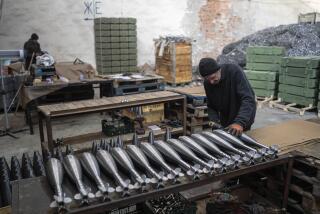COLUMN LEFT/ SEYMOUR MELMAN : America Can Turn Civilian, Successfully : Job conversion can be set in motion at local levels, with federal departments helping to coordinate, not dominate.
- Share via
Next month, Bill Clinton will become chief executive officer of the largest industrial labor force and the largest single aggregation of capital resources under one American management. The military industry engages 3 million persons. The Pentagon employs 1 million civilians and uniformed forces of 1.9 million.
The White House/Pentagon chiefs run 32,000 prime contractor industrial facilities. About 100,000 factories are subordinate to the primes. Annually, about one-third of the nation’s new fixed or working capital is used by the military. Among the largest economies, only the Soviets suffered a higher ratio of military to civilian use of capital. Since 1951, yearly Pentagon budgets exceeded the net profits of all American corporations.
American needs in infrastructure alone are now immense. They include housing, wholesale rebuilding of inner cities, roads, bridges, schools, water works, sewers, toxic and radioactive waste clean-up and modernization and electrification of railroad systems. Such efforts require an annual outlay of at least $165 billion.
Converting major parts of the immense military economy to civilian productive use could be constrained by two conventional power-wielding strategies, both ideologically reinforced.
The classic doctrine of laissez faire (no government intervention) now includes acceptability of major job loss and industrial decline through shut-downs or export of productive jobs. Incomes to senior officials of firms continue to rise, even while employment opportunity is sharply reduced and U.S. dependence on imported goods soars. But while laissez-faire ideologues exalt the free market and demean “government spending,” defense, the largest single item under federal administrative control, is exempted from their scrutiny. But the credibility of laissez faire collapses as people and facilities working for defense prove incapable of the swift flexibility assumed in the economic models. Thus, defense workers wield every form of non-laissez-faire pressure on Congress to continue their government funding.
Another proposal for conversion is offered by advocates of state managerialism who see high competence in central planning, thus disregarding the lessons of Soviet economy that included inability to convert. The staff of the Soviet State Planning Committee (Gosplan) was about 3,000. The Pentagon has outpaced this achievement by mounting an “acquisition” force of 580,000 civilian and military employees. But tracking details like chain-store inventories with computers is a routine task compared with designing or redesigning a production system for a unique product.
In sum, laissez faire would let it all rot; state managerialism would make inefficiency a national goal.
A combination of prudent doses of economic democracy and decentralized control offers an alternative to both the laissez-faire and state managerial models. Therefore, advanced planning for decentralized redesign of operations at defense-related factories, bases and laboratories can be the core of a highly effective economic conversion. Advanced planning is essential because of the time needed for blue-printing redesigned operations and to minimize disruptions from unemployment.
At every major defense facility, say of 100 employees or more, management- labor teams could investigate the market potentials of alternative products and devise the changes in job skills and production facilities. Alternative products can be drawn from three major groupings: goods once produced here that have been transferred for production abroad, the array of goods that would be required to modernize all the major aspects of infrastructure in American economy and new ideas.
Detailed blue-printing of infrastructure rebuilding can be set in motion in every city, county, state--with federal departments helping to coordinate, not dominate.
A Clinton Administration’s economic conversion effort, vigorously pursued, would create several million new jobs. For example, electrification of American railroads will require four years to create the new industries to make the trains and allied equipment. Building and operating these industries gives new value to peoples’ lives and will counter the human decay that now devalues whole communities and feeds rightist extremism and racism. But Clinton’s Administration must run fast enough to overcome the pace of decay of the permanent war economy. Or else there will be little to show for ordinary people after four years.
More to Read
Sign up for Essential California
The most important California stories and recommendations in your inbox every morning.
You may occasionally receive promotional content from the Los Angeles Times.













